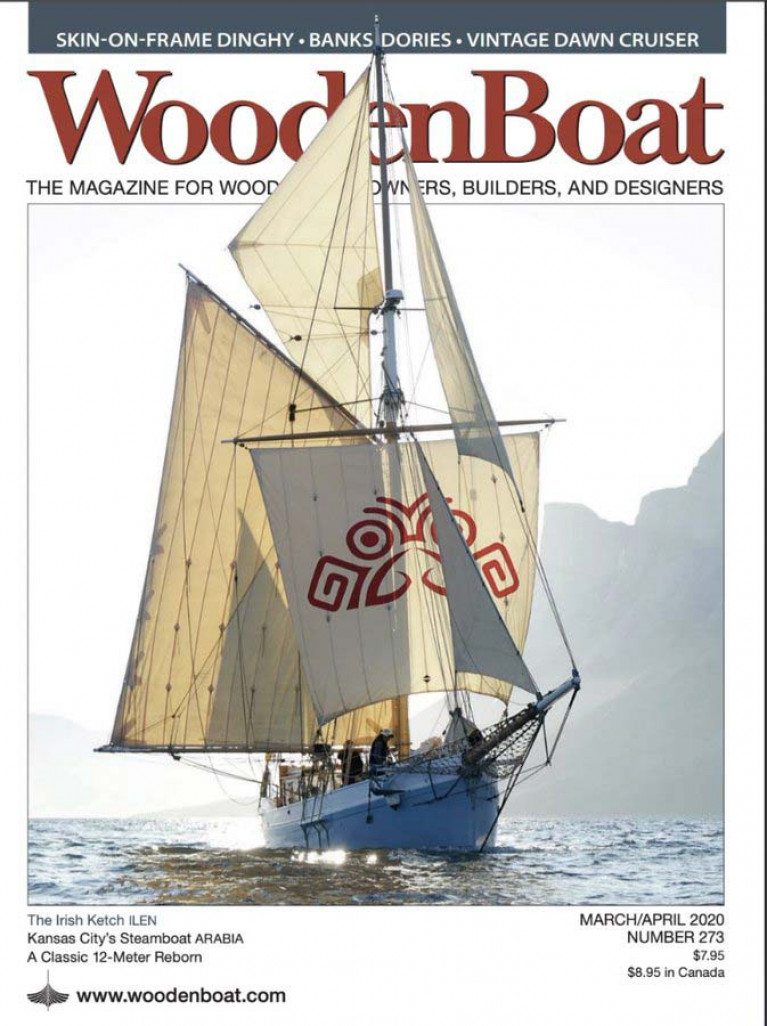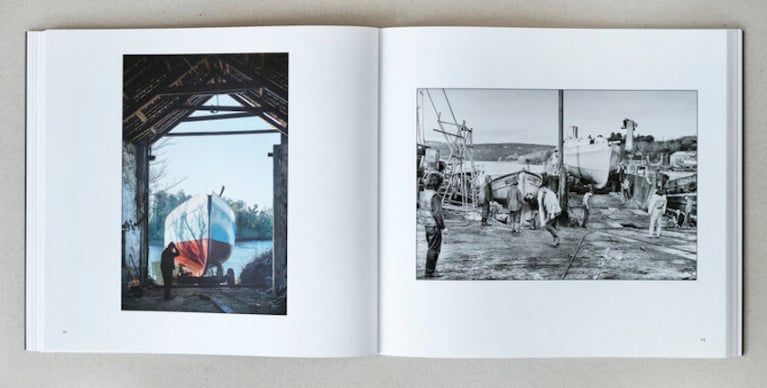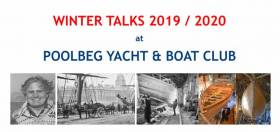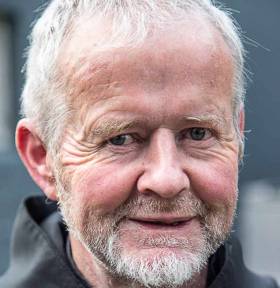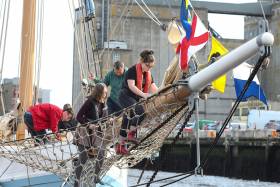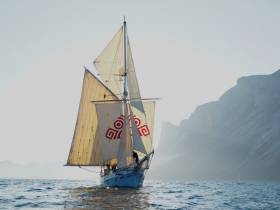Displaying items by tag: Ilen
Limerick Ketch Ilen DIY Kids’ Model Provides Handy Pint-Size Challenge for a €150 Prize
Junior and very junior sailors who’d like a special indoor Do-it-Yourself Challenge in these locked-in times will find something of special interest in the latest idea from current Irish Sailing Presidential Award holder Gary MacMahon of Limerick.
Gary received his award for his twenty-years of dedication in getting the 1926-built 56ft ketch Ilen of Conor O’Brien fame restored to such good seagoing order that, last summer, she voyaged to Greenland from Ireland and back, and collected other awards for that achievement.
This year the plan had been to have Ilen busy in and around the Shannon Estuary for the first half of the season, visiting all the local ports as part of her regular “Sailing into Wellness” programme. Then, on July 19th, she was to depart for Madeira to replicate the 1926 voyage Conor O’Brien made there with the ship, on his way to the Falklands, where Ilen was to spend her 40-year working life.
 Still seeing things differently through young eyes – Ilen’s delivery crew, and the ship herself
Still seeing things differently through young eyes – Ilen’s delivery crew, and the ship herself
But the COVID-19 lockdown has put that on hold for a year. However, one ray of hope is that if some sailing does resume in August, then Ilen may be able to make her first visit to the Cruinniu na mBad festival in Kinvara on Galway Bay – if it happens, this year’s is scheduled for 14th to 16th August.
Meanwhile, the Ilen team have been prevented from assembling in any way by current regulations in what would normally have been be a very busy time of joint effort for her fit-out programme, and thus the ship is effectively moth-balled in Limerick when she should already be sailing.
So in the meantime, one day Gary was idly observing a Tetrapak and got to thinking how it might be completely re-purposed to be the basis of a kids’ home project and competition for a €150 Amazon Gift Prize to create a pint-sized version of Ilen, complete with Conor O’Brien and the Cadogan cousins from Cape Clear, who crewed with him on the long voyage of 1926.
And yes, we know that a standard Tetrapak actually holds a litre, but for most of us “pint-size” has a much more resonant meaning. Take the basics off this pdf, and then you’ll just need a few little things that “should be readily available in a modern household….”
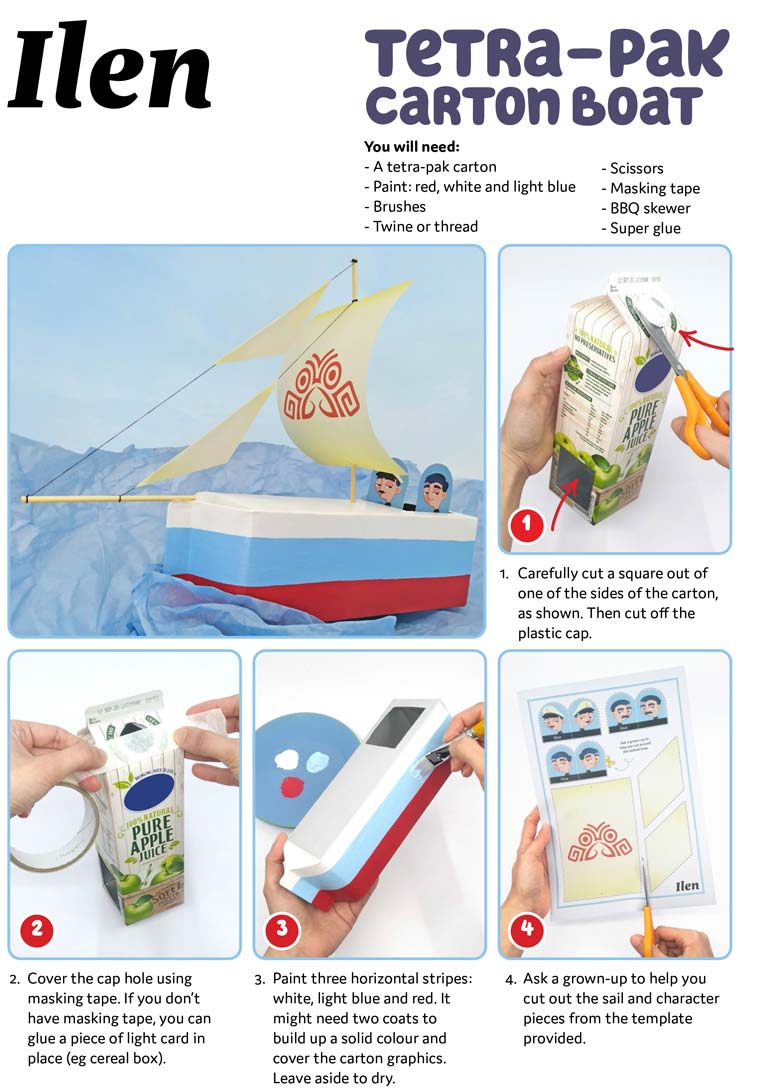 This is the cut-out-and-get-to-work department - Scroll down to the end of the article to download a PDF to make your own Ilen
This is the cut-out-and-get-to-work department - Scroll down to the end of the article to download a PDF to make your own Ilen
Oh yeah? We can see some mums and dads having kittens as they try to get their colour printer to work in order to create the cut-outs on a standard sheet of A4 paper, but not to worry, all will be well in the end. Have a care, though, when applying the specified Super-Glue – a kid-friendly paste from a squeezy tube or painted on with a sponge pen might be safer.
The key thing is to have the square-sail properly printed with the evocative Salmon’s Wake logo which set the tone for the Greenland voyage, and now seems to be the symbol for the entire Ilen project. Get that right, and then it’s Bon Voyage and good luck with the €150 prize. The competition ends on May 22nd.
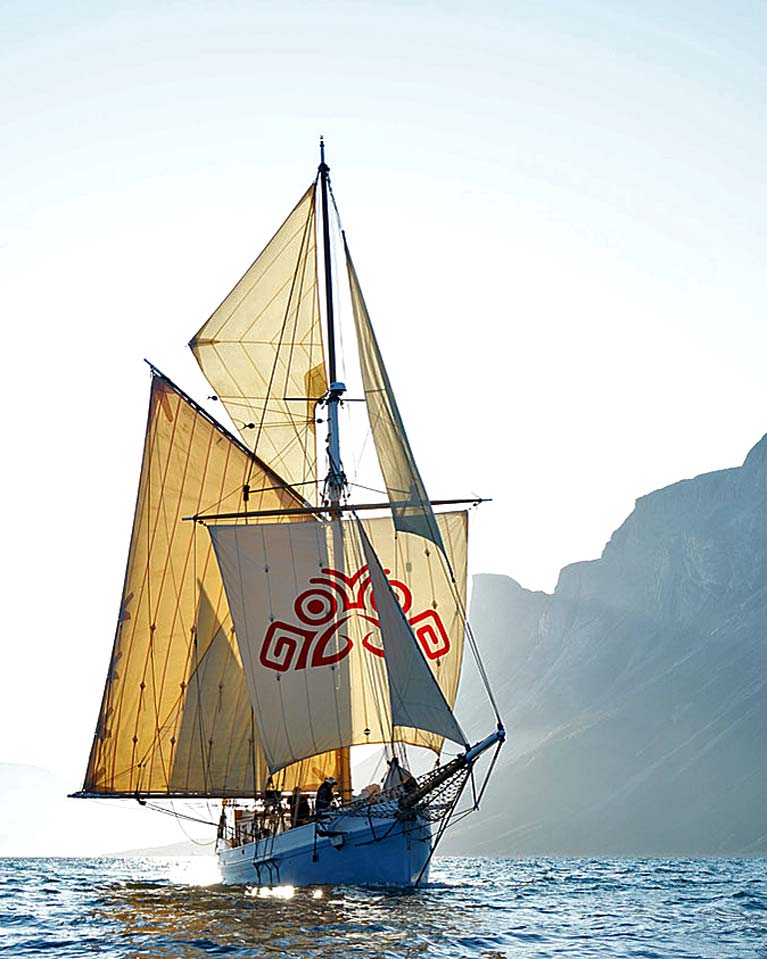 Award winner every which way – Ilen in Greenland. Photo: Gary Mac Mahon
Award winner every which way – Ilen in Greenland. Photo: Gary Mac Mahon
Ketch Ilen is Flagship for MacMahon Family’s Success Afloat
There were several notable Irish sailing families with their names up in lights more than once at Saturday evening’s virtual awards ceremony for the annual achievements in Irish sailing. But none could match the seaborn diversity of an ancient tribe whose ancestral lands are in south county Clare along the north shore of the Shannon Estuary, where they have developed a long and vibrant association with Limerick city.
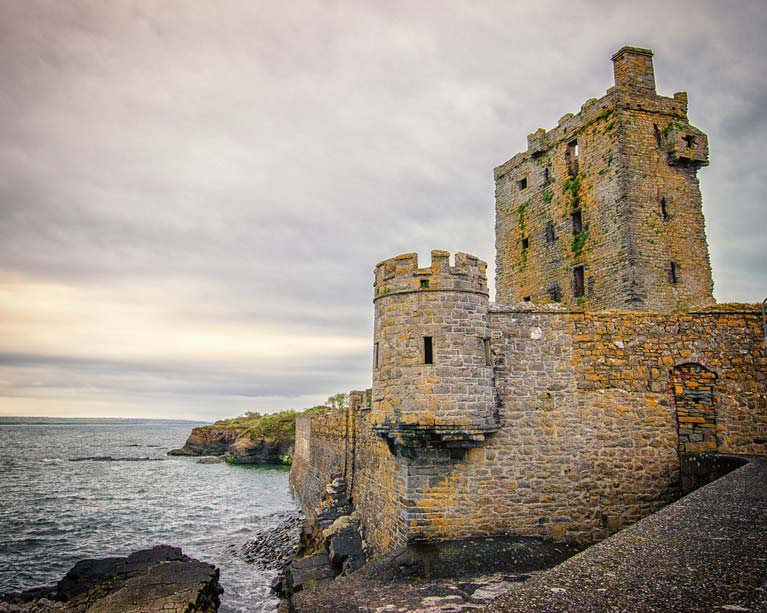 Carrigaholt Castle, stronghold of the Mac Mahons, was built around 1480 – twelve years before Columbus arrived in America.
Carrigaholt Castle, stronghold of the Mac Mahons, was built around 1480 – twelve years before Columbus arrived in America.
Yet like all Irish families of note, these days the Mac Mahons (or MacMahon or McMahon) also have a global presence, their most notable expats being in France. There, a descendent of one of the Wild Geese who left Ireland after the defeats of the wars in the 17th Century was Patrice de MacMahon (1808-1893), 6th Marquess of MacMahon and 1st Duke of Magenta, a noted soldier who rose to become a Marshal of France and then, on going into politics, was President of the French Republic from 1875 to 1879.
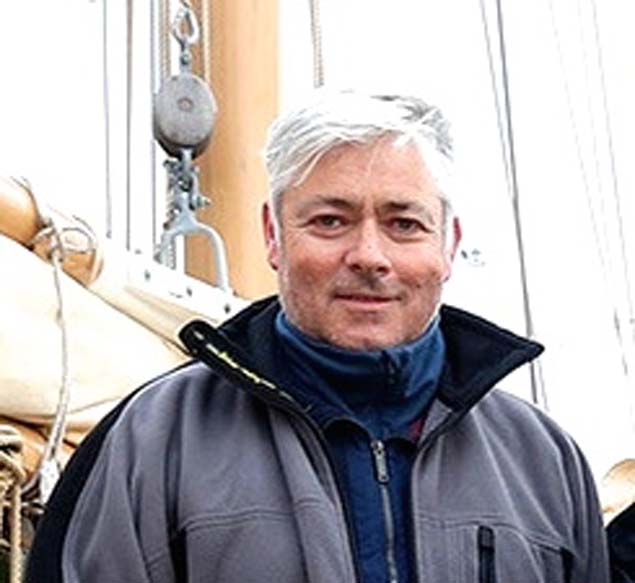 Gary Mac Mahon of Limerick aboard Ilen at Nuuk in Greenland
Gary Mac Mahon of Limerick aboard Ilen at Nuuk in Greenland
Back home meanwhile, the MacMahons who stayed on in Ireland gradually emerged from the years of conquered oppression to re-build their lives over generations, and they have long since been in roles of distinction in many areas of local and national life. But nevertheless Saturday’s awards were something special in the family’s long history, as Gary MacMahon of Limerick received the President’s Award for his many years of devotion to the cause of restoring the 56ft 1926-built Conor O’Brien trading ketch Ilen with such success that she was able to voyage to Greenland in 2019.
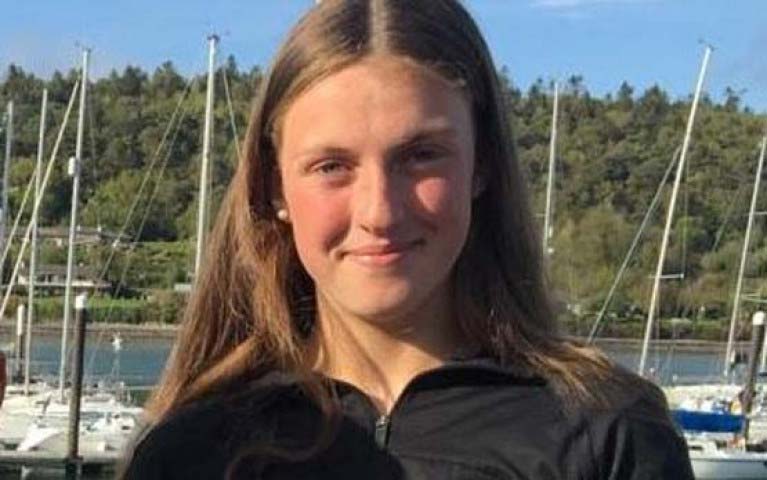 Eve McMahon of Howth, the new Youth Sailor of the Year
Eve McMahon of Howth, the new Youth Sailor of the Year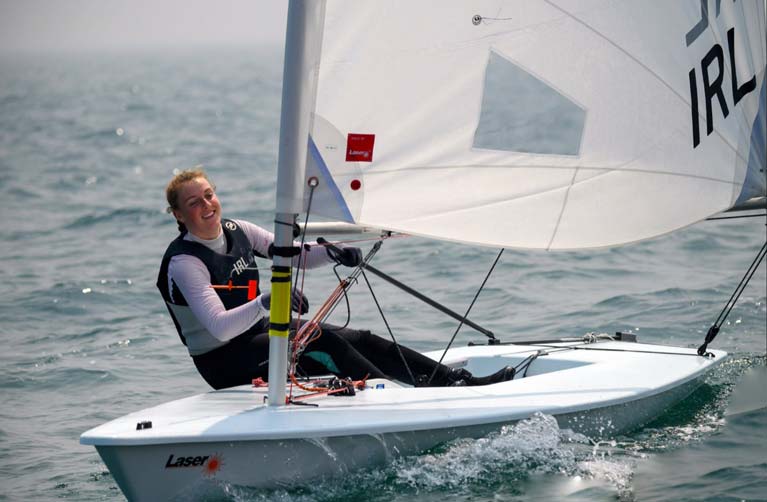 At home on the water – Eve McMahon with her Laser
At home on the water – Eve McMahon with her Laser
In a completely different area of sailing, Eve McMahon of Howth was honoured as Youth Sailor of the Year for taking Gold in the U17 Division in the Laser Youth Worlds in Canada and other successes, while her brother Jamie McMahon was the Junior Sailor of the Month for April on the strength of his victory as Laser Radial overall title-holder in the Irish Youth Championship in Crosshaven.
 Jamie McMahon, Junior Sailor of the Month for Aril 2019 after his convincing victory at the Irish Sailing Youth Championship at Royal Cork.
Jamie McMahon, Junior Sailor of the Month for Aril 2019 after his convincing victory at the Irish Sailing Youth Championship at Royal Cork. In control – Jamie McMahon on his way to winning the Youth Championship at Crosshaven. Photo: Robert Bateman
In control – Jamie McMahon on his way to winning the Youth Championship at Crosshaven. Photo: Robert Bateman
All these successes are very much of our time. But there was a special salute to the Mac Mahon history as Ilen took her departure from Limerick for Greenland in July 2019. Her final anchorage in the Shannon Estuary before taking on the Atlantic was at Carrigaholt, where the stronghold of Mac Mahons in southwest Clare – Carrigaholt Castle built around 1480s – still stands, now maintained by the office of Public Works as a well-preserved if empty shell which eloquently serves – as does Ilen herself – as a tangible link to times past.
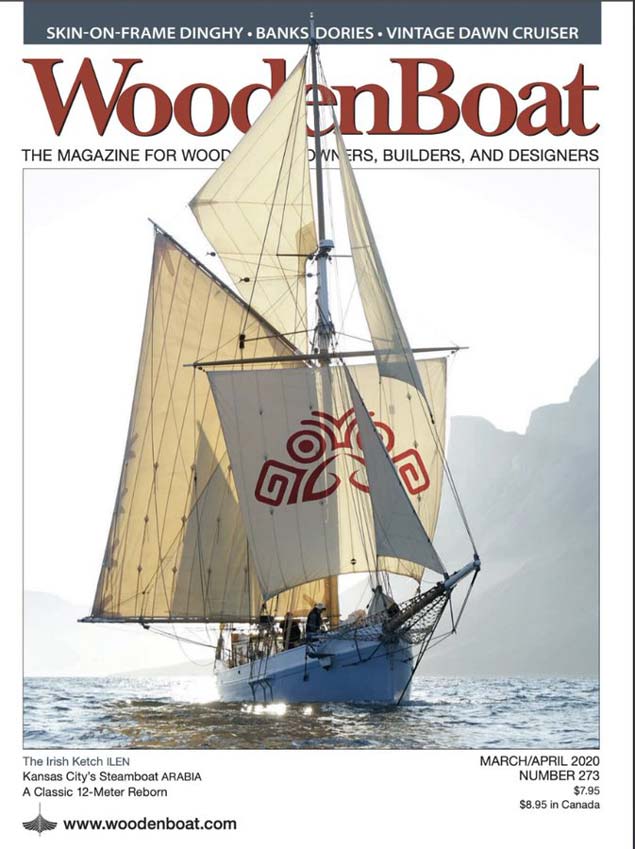 A Mac Mahon dream fulfilled – Ilen in Greenland provides a very memorable cover image for the current WoodenBoat magazine. Photo: Gary Mac Mahon
A Mac Mahon dream fulfilled – Ilen in Greenland provides a very memorable cover image for the current WoodenBoat magazine. Photo: Gary Mac Mahon
Limerick Ketch Ilen is WoodenBoat Magazine Cover Star
The Limerick ketch Ilen has received the ultimate accolade among classic and traditional boat restorations by being chosen as the cover star for the March/April 2020 issue of WoodenBoat, the American magazine which deservedly has a global reach and reputation in the challenging world of authentic restorations and re-builds.
The striking photograph of the 56ft 1926-built Conor O’Brien trading ketch was taken by Gary Mac Mahon off the mountainous coast of Southwest Greenland last summer, during Ilen’s Salmon’s Wake voyage of 2019 from her home port of Limerick to the Arctic mountains and small ports of West Greenland, and on to the capital city in the port of Nuuk
The sparkling and memorable image was a special reward for the photographer, as it was Gary Mac Mahon’s own unflinching belief in the Ilen Project which saw this unique vessel repatriated from the Falkland Islands to Ireland in 1997, with funds eventually being raised to restore her to full seagoing condition two decades later in a programme shared by the Ilen Boat-building School in Limerick and Hegarty’s Boatyard at Oldcourt on the Ilen River near Baltimore in West Cork, Ilen’s birthplace.
The magazine includes an account of Ilen’s restoration by Arista Holden, a traditional boat enthusiast from Maine (Belfast, would you believe), who led a group of fellow devotees last May to the Baltimore Woodenboat Festival, where Ilen had made her restored debut in 2018.
This isn’t the first time that a notable Irish boat restoration has been given the honours in WoodenBoat. The May/June 2008 issue featured Hal Sisk’s 36ft gaff cutter Peggy Bawn, designed by G L Watson of Glasgow, built by John Hilditch of Carrickfergus in 1894, and meticulousy restored under Hal’s overall direction by Michael Kennedy of Dunmore East with input from several noted specialists.
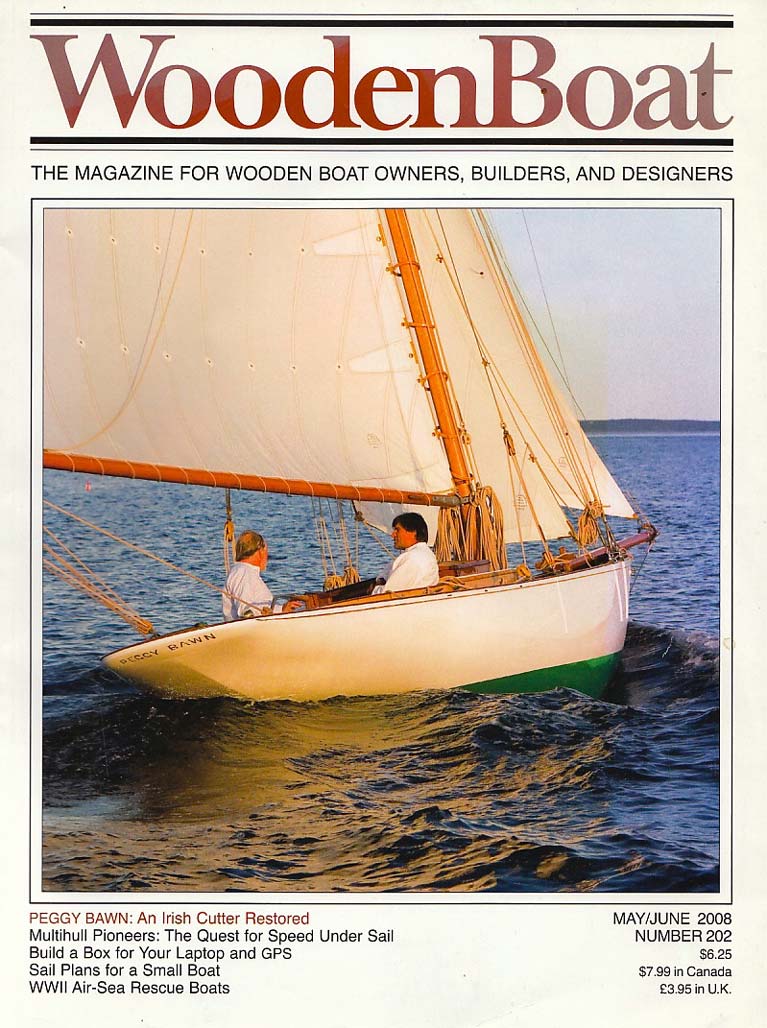 The image of Peggy Bawn in American waters in 2007 was created by legendary marine photographer Ben Mendlowitz, long associated with WooodenBoat. Photo: Benjamin Mendlowitz
The image of Peggy Bawn in American waters in 2007 was created by legendary marine photographer Ben Mendlowitz, long associated with WooodenBoat. Photo: Benjamin Mendlowitz
New Book Of Photos Tells Story Of Boatyard That Rebuilt Ilen
The Skibbereen boatyard where Ireland’s last trading schooner was painstakingly restored has been immortalised in a new book of photography, as The Irish Times reports.
Hegarty’s Boatyard, on the River Ilen near Skibbereen, is the last surviving traditional boatyard in Ireland and remains a hive of activity, mostly servicing the local fishing industry.
Its bigger jobs include the Cill Airne, a 1960s cruise ferry tender refurbished as a restaurant and bar that’s now moored on the Liffey in Dublin, and the ketch Saoirse — “the first boat to take the tricolour around the world in 1923”, according to Liam Hegarty — which is hoped to be ready for Baltimore’s Wooden Boat Festival next year.
But the yard that’s now the subject of a ‘photographic essay’ by Kevin O’Farrell is probably best known for Ilen, the rebuilt sailing ship that carried Limerick’s flag across the Atlantic to Greenland last summer and was more recently recognised at the best restoration project of 2019.
Limerick's Ilen Project has been presented with the Industrial Heritage Association of Ireland's Award for “Best Restoration of 2019” with its visionary management of the rebuilt sailing ship Ilen, and the associated community education work in Limerick. The Association’s President Paul McMahon presented the trophy at the IHAI Awards 2019 in the ESB Archive Building in Finglas. The ESB sponsored the event, and Michael English (IHAI Board Member) read the citation.
The Ilen during 2019 carried Limerick’s flag across the Atlantic to Greenland and back on the Salmons Wake research voyages, and having also confirmed that things are indeed cold within the Arctic Circle, she may set sail southwards for the islands of Madeira in 2020, as it was a port of call for Ilen during Conor O’Brien’s delivery voyage to the Falklands in 1926. The Ilen Project's marine educational programme has already extended to the islands, and the possible arrival of the ship has aroused local interest. It is now some ninety-five years since she last docked there, and her return visit to Funchal is eagerly awaited.
 Ilen in Greenland in the summmer of 2019. In 2020, a southward voyage to Madeira is an increasing possibility. Photo: Gary MacMahon
Ilen in Greenland in the summmer of 2019. In 2020, a southward voyage to Madeira is an increasing possibility. Photo: Gary MacMahon
The ship has turned out every bit as well as anyone expected. She has handled with equanimity whatever the North Atlantic threw at her this past summer. Her combination of sturdiness, elegance and speed win admiration wherever she goes.
The Ilen has also had a very full first operational season conveying community groups and individuals around the apectacular coast of Ireland. Her utility and attraction as a floating classroom and educational platform give credit to Limerick City and County Council, who provided funding through the Social Intervention Fund, to the JP McManus Benevolent Fund, and to all others who gave so generously of their time and treasure to bring her to where she is now.
A winter night's gathering in the familiar setting of Poolbeg Yacht & Boat Club in Ringsend in the heart of maritime Dublin can make it seem like summer again for a few magic hours, and this year’s programme, put together by Talks Organiser Darryl Hughes of the classic gaff ketch Maybird, is setting the bar high for his successors.
He has persuaded a varied, entertaining, informative and knowledgeable selection of five speakers to provide four shows, and it starts with renowned local and marine historian Cormac Lowth giving an impressive presentation on Dublin Port on Thursday, November 14th, and concludes with the historic Ilen Project’s Salmons Wake Voyage to West Greenland by Gary MacMahon on Thursday 19th March.
Brother Anthony Keane of Glenstal Abbey: Why Do We Own Boats?
Scribbler, my Sigma 33 yacht, was hauled ashore this week. Now she stands in her cradle in Castlepoint Boatyard in Crosshaven in Cork Harbour for her out-of-the-water winter rest. It is the annual end-of-season ritual. There are owners who don’t any more do an off-season haul-out. They winter on a marina, or on sheltered moorings and only haul for a hull-clean prior to the start of the new season. There are the particularly fortunate owners who can ‘winter’ their boats close to their homes, nicely at hand for the off-season maintenance work!
I come from the ‘old school’ thinking that it is best to ‘give the boat a dry-out.’ GRP, the plastic boats, benefit from it, I was told from the first boat purchase I made. Not everyone agrees these days but, whatever the off-season decision for your boat, the atmosphere that is about is definitely ‘end-of-season,’ with Autumnal and October cruiser Leagues concluding this weekend at clubs around the country.
More boats will be hauled ashore over the next week or so. There are the hardy souls in cruisers who sail on into December, when the weather can often be magnanimous, the dinghy sailors who do so year-round and the Lasers who ‘frostbite’.
As Scribbler was ‘laid-up’ this week I got to thinking about the perennial questions – why do we have boats, why do we go out in them and, of course, are they worth the expense and the effort needed to keep them going?
One of the best – and humorous – answers to those questions which I have heard came from Bro. Anthony Keane, who has been so much involved in the restoration of the famous Ilen. From Leitrim originally, he has been a monk at Glenstal Abbey since 1965 and his study of theology and wood in which he is quite an expert, as shown in the Ilen project, has enabled him to enjoin the topics with the maritime sphere and boating. I’ve admired the content of speeches he has made at the various stages of Ilen’s restoration and its launch and reported them here.
He was particularly outstanding at the launch of the restored Dublin Bay 21, Naneen, in Kilrush last month when I recorded his dissertation on why we have boats and go to sea. I’ve been waiting for the right moment to broadcast it, which has come with this week’s ‘hauling’ reflections.
Bro. Anthony’s thoughts on boats are worth listening to!
Listen to the Podcast below
Ilen Video Recounts Salmon’s Wake Voyage to Greenland
The Ilen Project has produced a short video (below) of its 2019 Salmon’s Wake Voyage, a sailing trip undertaken this summer from Ireland to Greenland.
It recounts ocean voyaging, navigating ice fields, coastal sailing off West Greenland and the way of a big timbered traditional Irish sailing ship going about her community business.
The video was shot and edited by Ilen project manager, Gary McMahon.
The 1926-built 56ft Conor O’Brien trading ketch Ilen of Limerick has had an exceptionally busy first season in 2019 in her restored condition as achieved by the Ilen Boat-Building School of Limerick, and Liam Hegarty’s Oldcourt Boatyard in West Cork.
This ambassadorial sailing ship has continued her 2019 community work - work which began last April on first departing Limerick Docks in full seagoing commission. Intertwined with many other objectives, the Ilen Project’s theme for this year was Salmon’s Wake, a concept whereby the ship’s voyaging shared 2019 with the International Year of the Salmon.
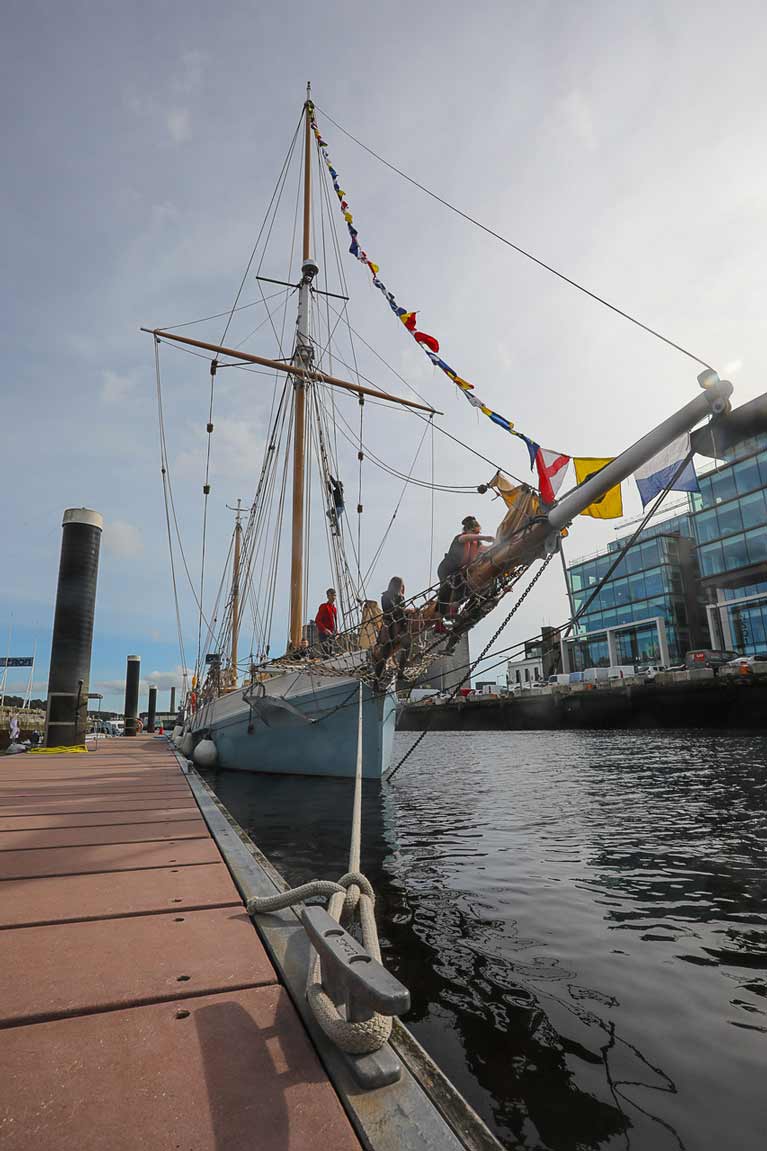 In from the sea, in from the Arctic – the much-travelled Ilen of Limerick makes her first visit to Cork City. Photo: Dermot Lynch
In from the sea, in from the Arctic – the much-travelled Ilen of Limerick makes her first visit to Cork City. Photo: Dermot Lynch
An international and local awareness around the declining numbers of Wild Salmon had prompted many communities around the North Atlantic to reflect on this reality - and to explore what the causes and effects might be. With a voyage along the salmon migratory routes to West Greenland, the Ilen was able to provide a central theme for the many salmon studies.
"This ambassadorial sailing ship has continued her 2019 community work"
Yet it is indicative of how busy the Ilen has been – and still is – that in her first year of operation in her restored condition, the Greenland Voyage has only been a highlight – albeit a very significant one – in a complex and varied programme to provide a productive first year of operation.
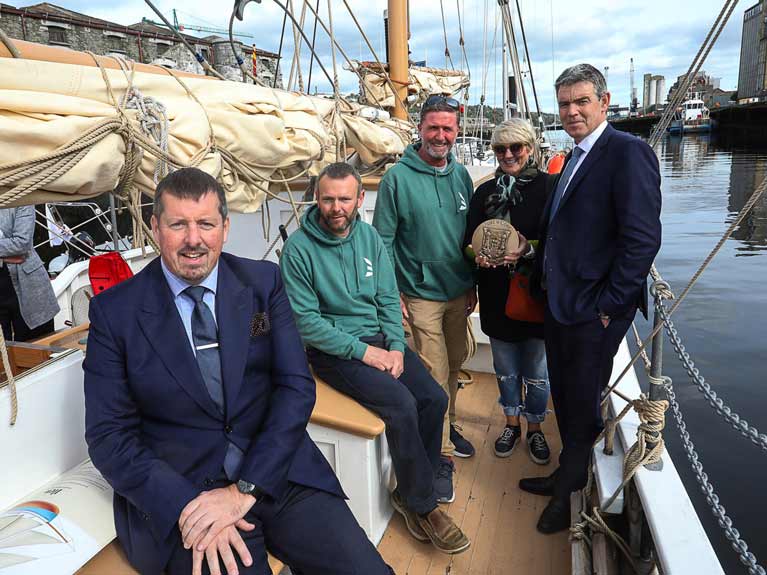 The Port of Cork welcomes Ilen with (left to right) Peter O’Shaughnessy (HR, Port of Cork), Colin Healy and James Lyons of Sailing into Wellness, Deirdre Power of the Ilen Project with the traditional gift of Port of Cork ship’s plaque, and Henry Kingston, Port of Cork Engineering Manager. Photo: Dermot Lynch
The Port of Cork welcomes Ilen with (left to right) Peter O’Shaughnessy (HR, Port of Cork), Colin Healy and James Lyons of Sailing into Wellness, Deirdre Power of the Ilen Project with the traditional gift of Port of Cork ship’s plaque, and Henry Kingston, Port of Cork Engineering Manager. Photo: Dermot Lynch
Ilen’s dedication to community educational initiatives has thus seen her visit up to twenty ports, complete two transatlantic crossings, cruise the West Coast of Greenland, and engage with hundreds of individuals and with numerous educational and care organisations across Ireland.
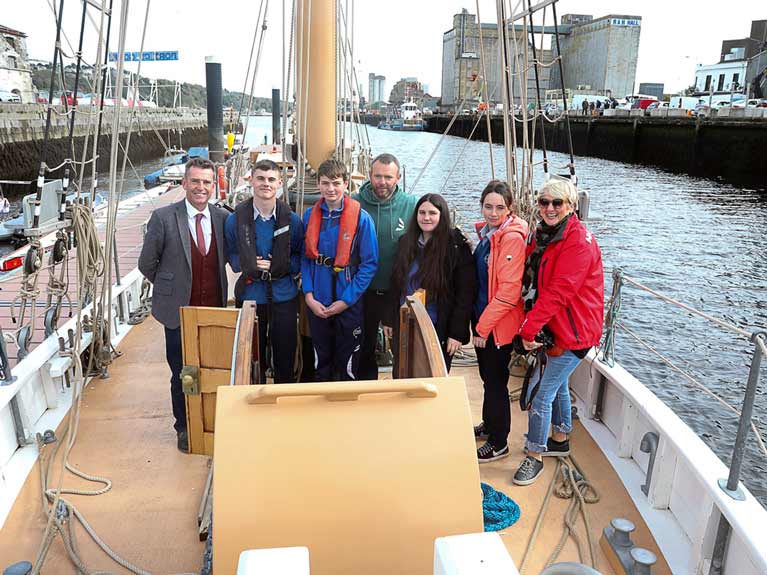 Neil Creedon (left), Deputy Principal of Terence MacSwiney Community College, Knocknaheeny, Cork, with (centre) James Lyons of Sailing Into Wellness and (right) Deirdre Power, Educational Facilitator of the Ilen Project, with students of Terence MacSwiney College aboard Ilen in the Port of Cork. Photo: Dermot Lynch
Neil Creedon (left), Deputy Principal of Terence MacSwiney Community College, Knocknaheeny, Cork, with (centre) James Lyons of Sailing Into Wellness and (right) Deirdre Power, Educational Facilitator of the Ilen Project, with students of Terence MacSwiney College aboard Ilen in the Port of Cork. Photo: Dermot Lynch
Even with the swift arrival of Autumnal weather, her mission continues, and recently she sailed into Cork City Centre – her first visit to the city, as Kinsale provides her south coast berth - to join in with Cork Mental Health Festival, where she was warmly welcomed and lauded for her work with youth and recovery groups. This was a joint visit by the Ilen Project and its partners Sailing into Wellness. Both organisations share a common community mission, and also find project expression in sailing ships upon the coastal waters of Ireland. – (Gary MacMahon - Ilen Project)
 In the heart of Cork - a very different place from Nuuk in Western Greenland, yet Ilen has been in both ports during her extensive 2019 voyaging. Photo: Dermot Lynch
In the heart of Cork - a very different place from Nuuk in Western Greenland, yet Ilen has been in both ports during her extensive 2019 voyaging. Photo: Dermot Lynch
The Ilen’s Gary Mac Mahon & Paddy Barry are Sailors of the Month (Cruising) for September
The long story of the re-birth of the 1926-built 56ft Conor O’Brien trading ketch Ilen of Limerick was acquiring an almost wraith-like aspect until in 2019 – the restoration job completed – she undertook the very tangible 5000 miles Salmons Wake voyage to Greenland for inter-cultural exchange, research into salmon migration, and data-acquisition on climate change. Project Director Gary MacMahon – whose unflinching faith has kept this extraordinary concept moving ahead – was skipper for the outward passage from Ireland, whiled seasoned voyager Paddy Barry – who was aboard throughout the time away from Ireland – brought Ilen home safely across the restless North Atlantic in unsettled early Autumn conditions.
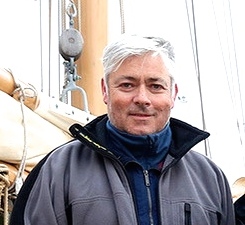 Gary Mac Mahon aboard Ilen in Nuuk – his sustained vision resulted in the restored Ilen’s successful voyage to Greenland. Photo: Chelsea Canavan
Gary Mac Mahon aboard Ilen in Nuuk – his sustained vision resulted in the restored Ilen’s successful voyage to Greenland. Photo: Chelsea Canavan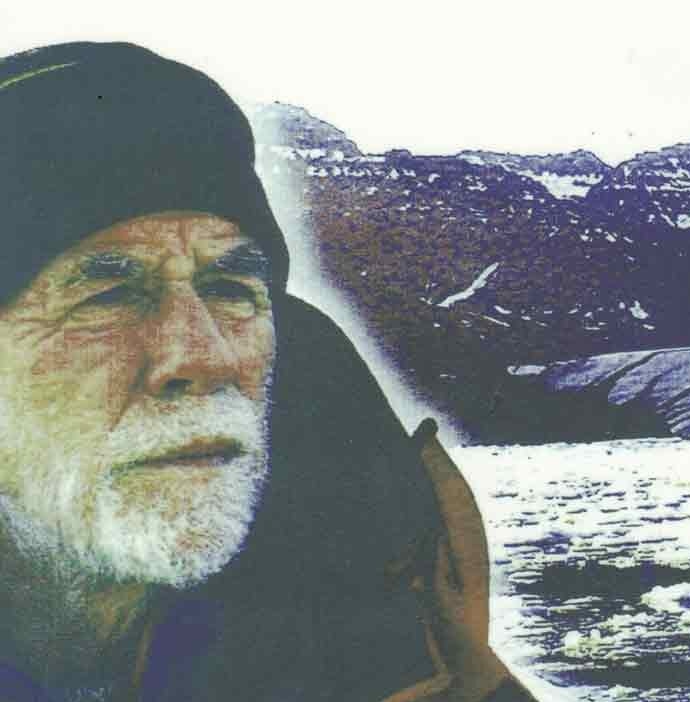 A man of the sea and the mountains and the ice – Paddy Barry safely skippered Ilen home from Greenland across a restless Autumnal North Atlantic
A man of the sea and the mountains and the ice – Paddy Barry safely skippered Ilen home from Greenland across a restless Autumnal North Atlantic




























